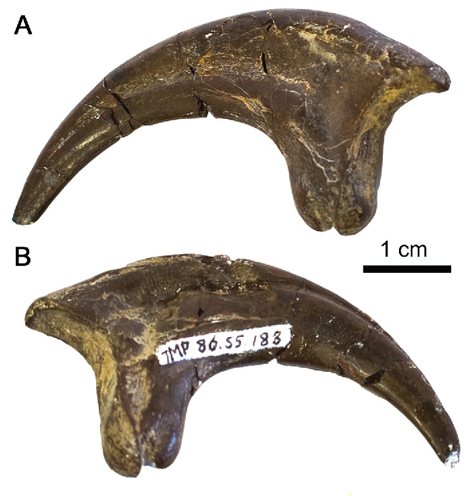New Dinosaur Described – Boreonykus certekorum
Canadian palaeontologist Philip Currie in collaboration with Australian Phil Bell has published a scientific paper announcing the discovery of a new meat-eating dinosaur, one that was very probably closely related to the famous Velociraptor. The fossils of a theropod dinosaur, described by a member of the Everything Dinosaur team as being “about the size of a German Shepherd dog”, come from an extensive dinosaur bonebed containing the remains of a number of huge horned dinosaurs (Pachyrhinosaurus).
Boreonykus certekorum
The shed teeth and isolated bones, including diagnostic cranial material that proved critical in the establishing of a new genus, had been preserved amongst the immense bones of the horned dinosaurs. These fossils provide evidence that a number of different types of carnivorous dinosaur would have scavenged the carcases of horned dinosaurs, possibly the victims of an attempt to cross a river in flood.
A Pair of Boreonykus Feeding on the Carcase of Pachyrhinosaurus
Picture credit: Canadian Press
The discovery of a frontal bone (a bone from the front of the skull), led to the erection of a new genus. The dinosaur has been named Boreonykus certekorum and a phylogenetic analysis indicates that this dinosaur was probably a descendent of Asian members of the Velociraptorinae sub-family of dromaeosaurids. The researchers propose that the ancestors of B. certekorum migrated across a land bridge from Asia into North America.
Polar Dinosaurs
The fossils come from the Wapiti Formation of north-western Alberta, Canada. The Pachyrhinosaurus bonebed is located at Pipestone Creek and the fossils have been dated to around 72.5 million years ago or thereabouts. Writing in the open access, on line journal “The Journal of Vertebrate Paleontology” the scientists suggest that Boreonykus is potentially a close relative of the famous Velociraptor from Asia.
The Sickle-shaped Killing Claw on the Second Toe of Boreonykus
Picture credit: The Journal of Vertebrate Paleontology
A Polar Climate
During the Late Cretaceous, this part of northern Canada would have been part of an extensive “polar” climate adjacent to an substantial inland sea. Although not as cold as this region of Canada today, Alberta in the Late Cretaceous would have suffered from long winters with plenty of snow and temperatures below freezing. It is likely that Boreonykus was covered in a thick coat of shaggy proto-feathers to help keep out the cold.
This small meat-eating dinosaur may not have been a permanent resident of this polar environment, however, it has been noted that relatively small dinosaurs such as Boreonykus would have found migrating long distances quite a challenge. Indeed, if the bonebed with the Pachyrhinosaurus fossils is anything to go by, there would certainly have been enough carcases in the area to sustain a population of Boreonykus dinosaurs through any long , dark winter.
For models and replicas of dromaeosaurs: Beasts of the Mesozoic Models.



